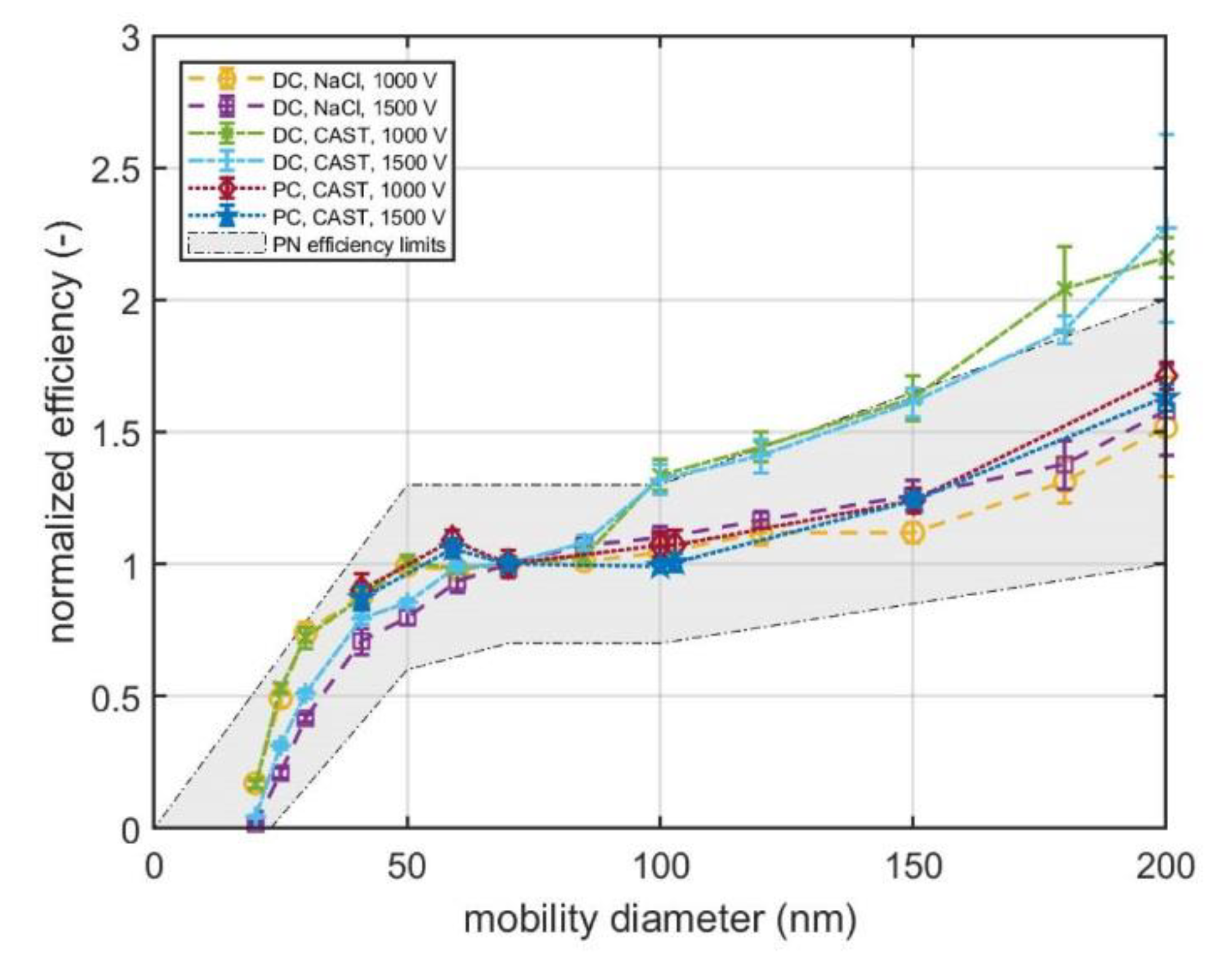Charging-Based PN Sensing of Automotive Exhaust Particles †
Abstract
:1. Introduction
2. Theory and Measurement Principle
3. Experimental
4. Results and Discussion
References
- Regulation No 83 of the Economic Commission for Europe of the United Nations (UN/ECE). Uniform Provisions Concerning the Approval of Vehicles with Regard to the Emission of Pollutants According to Engine Fuel Requirements. Available online: https://eur-lex.europa.eu/legal-content/EN/TXT/?uri=CELEX%3A42012X0215%2801%29 (accessed on 8 August 2016).
- Giechaskiel, B.; Maricq, M.; Ntziachristos, L.; Dardiotis, C.; Wang, X.; Axmann, H.; Bergmann, A.; Schindler, W. Review of motor vehicle particulate emissions sampling and measurement: From smoke and filter mass to particle number. J. Aerosol. Sci. 2014, 67, 48–86. [Google Scholar] [CrossRef]
- Commission Regulation (EC) No 692/2008 of 18 July 2008 Implementing and Amending Regulation To, No 715/2007 of the European Parliament and of the Council on Type-Approval of Motor Vehicles with Respect Repair, Emissions from Light Passenger and Comm. Technical Report. 2008. Available online: https://eur-lex.europa.eu/legal-content/en/ALL/?uri=CELEX%3A32008R0692 (accessed on 8 August 2016).
- Änderung der Richtlinie für die Durchführung der Untersuchung der Abgase von Kraftfahrzeugen nach Nummer 6.8.2 der Anlage VIIIa Straßenverkehrs-Zulassungs-Ordnung (StVZO) (AU-Richtlinie). Available online: https://www.amz.de/verkehrsblatt-11-2018/150/4876/108626/ (accessed on 02 01 2019).
- Schriefl, M.A.; Bergmann, A.; Fierz, M. Characterization and Modelling of a Novel Particle Number Detector. In Proceedings of the EAC, Tours, France, 4–9 September 2016. [Google Scholar]
- Burtscher, H.; Schmidt-Ott, A. Verfahren und Vorrichtung zur Messung der Anzahlkonzentration und des Mittleren Durchmessers von in Einem Trägergas suspendierten Partikeln, EP 1,655,595 A1, 10 May 2006. [Google Scholar]
- Burtscher, H.; Scherrer, L.; Siegmann, H.C.; Schmidt-Ott, A.; Federer, B. Probing Aerosols by Photoelectric Charging. J. Appl. Phys. 1982, 53, 3787–3791. [Google Scholar] [CrossRef]
- Fierz, M.; Meier, D.; Steigmeier, P.; Burtscher, H. Aerosol Measurement by Induced Currents. Aerosol. Sci. Technol. 2014, 48, 350–357. [Google Scholar] [CrossRef]
- Nishida, R.T.; Boies, A.M.; Hochgreb, S. Measuring ultrafine aerosols by direct photoionization and charge capture in continuous flow. Aerosol. Sci. Technol. 2018, 6826, 1–11. [Google Scholar] [CrossRef]
- Giechaskiel, B. Real Driving Emissions (RDE): Particle Number (PN) Portable Measurement Systems (PEMS) Calibration; Publications Office of the European Union: Luxembourg, 2018. [Google Scholar] [CrossRef]
- Giechaskiel, B.; Riccobono, F.; Bonnel, P. Feasibility Study on the Extension of the Real Driving Emissions (RDE) Procedure to Particle Number (PN); Publications Office of the European Union: Luxembourg, 2015; pp. 1–83. [Google Scholar] [CrossRef]
- Scheibel, H.G.; Porstendörfer, J. Generation of monodisperse Ag- and NaCl-aerosols with particle diameters between 2 and 300 nm. J. Aerosol. Sci. 1983, 14, 113–126. [Google Scholar] [CrossRef]
- Bescond, A.; Yon, J.; Ouf, F.X.; Ferry, D.; Delhaye, D.; Gaffié, D.; Coppalle, A.; Rozé, C. Automated determination of aggregate primary particle size distribution by tem image analysis: Application to soot. Aerosol. Sci. Technol. 2014. [Google Scholar] [CrossRef]
- Shin, W.G.; Wang, J.; Mertler, M.; Sachweh, B.; Fissan, H.; Pui, D.Y. The effect of particle morphology on unipolar diffusion charging of nanoparticle agglomerates in the transition regime. J. Aerosol. Sci. 2010, 41, 975–986. [Google Scholar] [CrossRef]
- Jung, H.; Kittelson, D.B. Characterization of aerosol surface instruments in transition regime. Aerosol. Sci. Technol. 2005, 39, 902–911. [Google Scholar] [CrossRef]


Publisher’s Note: MDPI stays neutral with regard to jurisdictional claims in published maps and institutional affiliations. |
© 2019 by the authors. Licensee MDPI, Basel, Switzerland. This article is an open access article distributed under the terms and conditions of the Creative Commons Attribution (CC BY) license (https://creativecommons.org/licenses/by/4.0/).
Share and Cite
Schriefl, M.A.; Longin, M.; Bergmann, A. Charging-Based PN Sensing of Automotive Exhaust Particles. Proceedings 2018, 2, 805. https://doi.org/10.3390/proceedings2130805
Schriefl MA, Longin M, Bergmann A. Charging-Based PN Sensing of Automotive Exhaust Particles. Proceedings. 2018; 2(13):805. https://doi.org/10.3390/proceedings2130805
Chicago/Turabian StyleSchriefl, Mario Anton, Matthias Longin, and Alexander Bergmann. 2018. "Charging-Based PN Sensing of Automotive Exhaust Particles" Proceedings 2, no. 13: 805. https://doi.org/10.3390/proceedings2130805
APA StyleSchriefl, M. A., Longin, M., & Bergmann, A. (2018). Charging-Based PN Sensing of Automotive Exhaust Particles. Proceedings, 2(13), 805. https://doi.org/10.3390/proceedings2130805




